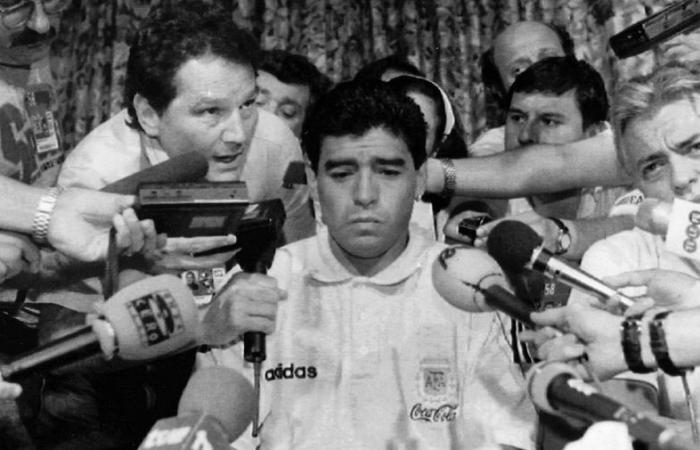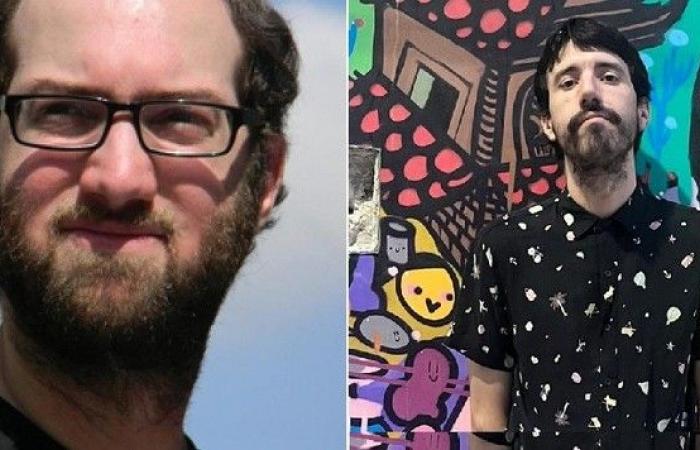The image, recorded on a VHS of dubious quality, is easily found on YouTube. There he is seen, sitting in an armchair of a body in the lobby of a hotel in Dallas, Texas. White sweater, short, neat hair, tanned skin, eyelids noticeably whitish due to the television spotlights. At his right hand, Adrian Paenzayears later becoming a mathematical popularizer, interviewed him for Channel 13. Whoever speaks, with clenched teeth and glassy eyes, is the most human of the gods, as Eduardo Galeano knew how to baptize him. The kid from Fiorito, the hero of ’86 and the popular idol undisputed.
Diego Armando Maradona He had received, perhaps, the biggest blow of his entire sports career. “I prepared very well for this World Cup. I prepared like never before”, he repeated, looking at the floor, perhaps remembering that great goal against Greece in the debut. It was going to be his last World Cup experience and it seemed like it would end in the worst way. Once again, the ghost of drugs stalked him. But, this time, he swore and swore until he cried that He hadn’t taken drugs.
And he would fire a phrase, like so many others that he has immortalized, that would remain for history: “I don’t want to dramatize but believe me, they cut off my legs.. I didn’t run for drugs. I ran for my heart and for my shirt. Nothing else”.
On the other side of the television, among the millions of Argentines glued to the broadcast crying alongside their idol, were two children. “I was 5 years old so I have no memories of that moment,” he tells Clarín Culture Martín Olivé. The other, Gonzalo Penasfrom seven to eight, recalls: “I devoured the magazine on Graphic. I remember the night before the number with the famous cover that says “The Truth” arrived home and that was going to deal with Diego’s doping case, breaking news arrived: there is a positive doping in Argentina and it was rumored that It was Diego. My old man and I looked at each other. He understood that that was a mess.”
Journalists and football fans
Today, three decades laterboth children became adults, journalists and soccer fans have gathered to revisit those events from testimonies, research and lots of archival material both national and international.
This is how it was born The day they cut off our legs. Edited digitally and self-managed, the book reviews the moments prior to Diego’s doping, added to the repercussions and memories of various figures from sports, art and culture who go from Eduardo Longoni, the photographer who captured that famous postcard of “the hand of God” in the 86 World Cup, andxfootballers like Jorge Vivaldo or Alberto Márcico and journalists who covered the event, such as Ezequiel Fernandez Moores.
Fernando Signorini, Diego’s historic personal physical trainer, who accompanied him in that preparation in La Pampa, in the middle of nowhere, which Rocky Balboa, months before the 94 World Cup, writes in the prologue: “I felt that, as always, power had instrumentalized him, had used him as so many times before it had happened. Until when he arrived in Argentina with the World Cup in Mexico and they took them to the balcony of the Casa Rosada. Once again, power, regardless of who was in government at that time, uses the success of these children who, when they are in their place of origin, which are popular neighborhoods, slums, not only ignore them but also despise them.” .
“The project arose thanks to SaviorsGreen Day’s latest album,” Olivé tells Clarín Culturedemonstrating what is another of the passions that connects both authors: punk rock. “We wanted to write something together and We find ourselves with the anniversary of the 30th anniversary of the 94 World Cup, which we remember as a great edition, and also the pain of Diego’s doping. We decided to focus on that thinking about a joint note. When we saw all the material we had we said: this is a book,” Penas completes.
Regarding archival work, Penas confesses to being a avid magazine collector The Graphic, Goalsguides and sports supplements. “I have a great archive of that World Cup. One of the things that surprised me the most was how quickly everything happened: Diego returned to the National Team in the summer of ’93 but he did not play in the qualifying rounds. He watches the historic 0-5 defeat against Colombia from the stands and the people applaud him. A few days later, he signed with Newell’s and played in the playoffs with Australia. All in a handful of months. “That was his life,” he says.
Olivé was in charge of contacting foreign journalistsone of the greatest attractions of the book: Testimonies from correspondents from Australia, Greece, Nigeria, Bulgaria and Romania are included..
He expands: “I was surprised, when reading the newspapers and talking to journalists, by the disbelief at the news. Bulgarians and Romanians believed until the last moment that Diego was finally going to play. It was a different time, the news also moved at a different pace.”
Regarding this last country, it is curious what they say about George Hagi, its greatest figure, who had faced Diego in the 90 World Cup and wanted his revenge: “For Hagi, facing Maradona was a matter of honorhe wanted another direct duel to show him and the world what he was capable of,” they write.
Conspiracy theories
They also delve into conspiracy theories that are revived by many of the testimonies, interviewed and even Signorini himself slips it into the prologue. Was there a black hand against Maradona? Did Joao Havelange, Brazilian, president of FIFA, have anything to do with it? Was Don Julio Humberto Grondona, later anointed vice president of the highest entity in world football, involved?
“There was the idea that Argentina had to be removed because it had become a serious candidate for the title overnight and the idea of removing Diego due to the comparison with that Spanish player who had consumed the same substance in the 86 World Cup. In the book by Alejandro Wall and Andrés Burgo (The last Maradona) it is explained that The Argentine appeal also arrived late. “How do you understand the idea of thinking that you took a substance that was not allowed and you are late to the appeal with the idea of the plot?” Penas asks.
“As Signorini told us, Grondona, who was the president of the delegation that presented a player who had to be suspended for doping, was awarded the vice presidency of FIFA. Today we will no longer know exactly what happened.”says Olivé.
Hand in hand with the memory of doping, the famous phrase “They cut off my legs” and Maradona’s last World Cup On North American soil, another parallel arises, with other edges, linked to the other greatest soccer idol who today is leading one of the most successful cycles in the history of the Argentine National Team: Will Lionel Messi also have his last World Cup in the US in 2026?
The authors are encouraged to hypothesize and point out differences: “Messi declared that he does not want to play in the next World Cup. I see difficult. I don’t see it so similar because Diego arrived at the World Cup after a suspension and his departure in Naples, having to get physically ready because he hadn’t been playing. On the other hand, Messi, if he played in the World Cup, would do so while being active playing for Inter Miami,” clarifies Olivé.
Penalties match and add a similarity: “If he wants to play, he will play, I have no doubt about it. In other words, it is similar to Diego’s case. If he wants to play, he will do everything possible to make it happen. I hope he plays.”
Smell of plot
After learning the sad news, with the whiff of a plot floating in the air, The elimination of that team led by Coco Basile could be seen coming. That team, which had been two-time champion of America and was undefeated in 31 games between 1991 and 1993 until being surpassed by Scaloneta, would lose to Bulgaria in the first phase and would say goodbye with a 2-3 win against Hagi’s Romania, being eliminated. in the round of 16.
Today, thirty years laterthe memory of the most tragic chapter in the football and personal history of Diego Armando Maradona is revisited in different ways.
“It is the saddest memory that this football town has. –Olivé ruling–. Neither the elimination of 2002 nor the debacle of Sweden 58 can be compared because it is not because of the elimination from the World Cup, that no longer mattered: it is the impact of the attack on Diego. He is a thorn in the side of Argentina fans. “That still continues to hurt, especially because nothing could be done to defend him after he had defended this country and its people so much.”
“It was a thorn in Diego’s side because of everything that the blue and white means to him. Although he later returned to football – none other than the club he loves, Boca Juniors – and a whole generation, including myself, enjoyed it to the fullest,” says Penas, who He remembers having followed all the matches of that Apertura 95 in La Bombonera.
Expands: “That national wake It transformed into something else, like the pain transcended. Culturally speaking, it is interesting how various songs or writers, like Galeano, portray that Maradona. The defeated I think of songs like ‘Maradó’, by Los Piojos or ‘El francotirador’, by Attaque 77. I think it’s because a large part of society is reflected. They say: he is a God who makes mistakes, who has his dark side.”
Gonzalo Penas basic
- He has a degree in Communication Sciences (UBA) and a teacher.
- He is co-author of RW. Rodolfo Walsh in comics (Kill the messenger, 2016). He published the poems Decongestion (The Cursed Part Editions, 2011) and Notifications (Ícara Poesía, 2018).
- As a journalist, he worked independently in print and digital publications, on radio and television. He currently runs the podcast recently listened toa history of the underground through music.
Martín Olivé basic
- He is a Higher Technician in Sports Journalism (Deportea).
- He is co-author of You’ll Never Walk Alone: Klopp’s revolution at Liverpool (Football Book, 2020).
- He has been working on different independent graphics, radio and television projects for fourteen years.



